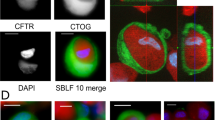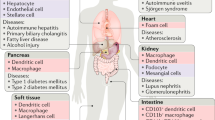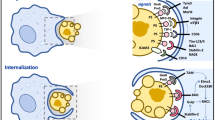Abstract
PHAGOCYTE recognition of cells that have undergone apoptosis (programmed cell death) is an event of broad biological significance. Characterized by endogenous endonuclease activation1, which results in chromatin fragmentation and nuclear condensation2, apoptosis leads to swift ingestion of intact but 'senescent' or 'unwanted' cells by phagocytes in processes as diverse as the physiological involution of organs, the remodelling of embryonic tissues, and metamorphosis3. The cell-surface mechanisms by which macrophages recognize apoptotic cells as 'senescent-self' have remained obscure. Here we report that macrophage recognition of apoptotic cells (both neutrophils and lymphocytes) is mediated by the vitronectin receptor, a heterodimer belonging to the β3 or cytoadhesin family of the integrins4–9. Previously, the functions of the vitronectin receptor were believed to be limited to cell anchorage10–12, but our findings indicate that the receptor has a novel and direct role in self–senescent-self intercellular recognition leading to macrophage phagocytosis of cells undergoing apoptosis.
This is a preview of subscription content, access via your institution
Access options
Subscribe to this journal
Receive 51 print issues and online access
$199.00 per year
only $3.90 per issue
Buy this article
- Purchase on Springer Link
- Instant access to full article PDF
Prices may be subject to local taxes which are calculated during checkout
Similar content being viewed by others
References
Wyllie, A. H. Nature 284, 555–556 (1980).
Wyllie, A. H., Morris, R. G., Smith A. L. & Dunlop, D. J. Pathol. 142, 62–77 (1984).
Wyllie, A. H., Kerr, J. F. R & Currie, A. R. Int. Rev. Cytol. 68, 251–306 (1980).
Pytela, R., Piersbacher, M. D. & Ruoslahti, E. Prod. natn. Acad. Sci. U.S.A. 82, 5766–5770 (1985).
Hynes, R. O. Cell 48, 549–554 (1987).
Ruoslahti, E. R. & Piersbacher, M. D. Science 238, 491–497 (1987).
Pytela, R., Piersbacher, M. D., Ginsberg, M. H., Plow, E. F. & Ruoslahti, E. Science 232, 1559–1561 (1986).
Charo, I. F., Bekeart, L. S. & Steiner, B. et al. Proc. natn. Acad. Sci. U.S.A. 83, 8351–8355 (1986).
Phillips, D. R., Charo, I. F., Parise, L. V. & Fitzgerald, L. A. Blood 71, 831–843 (1988).
Charo, I. F., Bekeart, L. S. & Phillips, D. R. J. biol. Chem. 262, 9935–9938 (1987).
Cheresh, D. Proc. natn Acad. Sci. U.S.A. 84, 6471–6475 (1987).
Cheresh, D. & Harper, J. R. J. biol. Chem. 262, 1434–1437 (1987).
Savill, J. S. et al. J. clin. Invest. 83, 865–875 (1989).
Newman, S. I., Henson, J. E. & Henson, P. M. J. exp. Med. 156, 430–442 (1982).
Savill, J. S., Henson, P. M. & Haslett, C. J. clin. Invest. 84, 1518–1527 (1989).
Nachman, R. L. & Leung, L. L. K. J. clin. Invest. 69, 263–269 (1982).
Piersbacher, M. D. & Ruoslahti, E. R. Nature 309, 30–33 (1984).
Wright, S. D. Meth. Enzym. 132, 204–221 (1986).
Burns, G. F., Cosgrove, L., Triglia, T. et al. Cell 45, 269–280 (1986).
Brown, E. J., & Goodwin, J. L. J. exp. Med. 167, 777–793 (1988).
Davies, J. et al. J. Cell Biol. 109, 1817–1826 (1989).
Gresham, H. D., Goodwin, J. L., Allen, P. M., Anderson, D. C. & Brown, E. J. J. Cell Biol. 108, 1935–1943 (1989).
Cheresh, D., Smith J. W., Cooper, H. M. & Quaranta, V. Cell 57, 59–68 (1989).
Freed, E., Gailit, J., van der Geer, P., Ruoslahti, E. & Hunter, T. EMBO J. 8, 2955–2965 (1989).
Brown, D. L., Phillips, D. R., Damsky, C. H. & Charo, I. F. J. clin. Invest. 84, 366–370 (1989).
Myons, B. L., Datzell, J. G., Hogg, N. & Ross, G. D. J. clin. Invest. 82, 640–651 (1988).
Wright, S. D. & Detmers, P. A. J. Cell Sci. (Suppl.) 9, 251–306 (1988).
Savill, J. S. thesis, Univ. London (1989).
Morganelli, P. M. & Guyre, P. M. J. Immun. 140, 2296–2304 (1988).
Hubbard, A. L. & Cohn, Z. A. J. Cell Biol. 64, 438–460 (1975).
Author information
Authors and Affiliations
Rights and permissions
About this article
Cite this article
Savill, J., Dransfield, I., Hogg, N. et al. Vitronectin receptor-mediated phagocytosis of cells undergoing apoptosis. Nature 343, 170–173 (1990). https://doi.org/10.1038/343170a0
Received:
Accepted:
Issue Date:
DOI: https://doi.org/10.1038/343170a0
This article is cited by
-
Stabilin-2 mediated apoptotic cell phagocytosis induces interleukin-10 expression by p38 and Pbx1 signaling
Cell Biochemistry and Biophysics (2024)
-
Targeting Tyro3, Axl and MerTK (TAM receptors): implications for macrophages in the tumor microenvironment
Molecular Cancer (2019)
-
Investigating the Proteomic Profile of HT-29 Colon Cancer Cells After Lactobacillus kefiri SGL 13 Exposure Using the SWATH Method
Journal of the American Society for Mass Spectrometry (2019)
-
DEL-1 promotes macrophage efferocytosis and clearance of inflammation
Nature Immunology (2019)
-
Molecular Camouflage of Plasmodium falciparum Merozoites by Binding of Host Vitronectin to P47 Fragment of SERA5
Scientific Reports (2018)
Comments
By submitting a comment you agree to abide by our Terms and Community Guidelines. If you find something abusive or that does not comply with our terms or guidelines please flag it as inappropriate.



